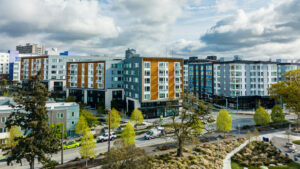Experts have long warned of a “retail apocalypse” as consumers shift to shopping online rather than at brick-and-mortar outlets. It appeared the predicted disaster had arrived in 2020 when the COVID-19 lockdowns wreaked havoc on retail outlets selling goods ranging from toys to candles. Over 15,000 stores closed in 2020 alone and numerous household names filed for bankruptcy, including J.C. Penney, Nieman Marcus, Tuesday Morning, and Stock+Field. Now, however, it seems the worst has passed. Dire predictions of vacant storefronts dotting the streets of major cities throughout the United States haven’t come to pass. On the contrary, the vacancy rate for shopping centers is a mere 5.3%. Asking rents are up 4% from 2023 and 17% from 2019. Retailers announced over 1,000 net new store openings in 2023. Even struggling retailers such as Toys R Us and Macy’s are planning on opening new locations.
One reason why commercial retail space is performing well this year is a rise in consumer spending. Retail sales in 2023 were 3% higher than in 2022. The Consumer Confidence Index rose from 101 in November 2023 to a whopping 110.7 in December 2023. The labor market is strong, the economy is doing well, and people are eager to enjoy their hard-earned cash. At the same time, construction of new retail space has lagged. Only 8 million square feet of new space was built in 2022, down from about 20 million square feet in 2019. What’s more, about 140 million square feet of retail space was demolished from 2013 to 2023, leaving retailers with few options at a time when they’re not the only ones interested in what is traditionally used for retail space. Medical offices, fitness centers, dental clinics, and even daycare centers are leasing storefront properties to make their businesses more accessible and convenient to their target audiences. This leaves even less space than ever for retailers who want to start a new venue or expand their current operations.
However, it’s not only strong consumer spending and a lack of retail space that are pushing the price of commercial retail space upward. Perhaps the main reason why the brick-and-mortar retail sector hasn’t collapsed is that retailers have learned how to adapt to the rise in e-commerce shopping. Rather than viewing online shopping as direct competition to in-person shopping, many stores have adapted to make it easy for consumers to buy goods where and when they choose. They’ve come to realize that many buyers will either see an item online and then come to a store to buy it in person, or view something in person and then go online to buy it. Thus, a physical store plays an integral role in driving sales, which means that shutting down brick-and-mortar outlets can have a negative effect on a business rather than helping it save money by cutting costs. Furthermore, it appears that even consumers have adjusted their expectations in recent years. Rather than embracing the convenience of ordering everything online, many have found they prefer to buy or at least view unfamiliar items or brands in person before making a purchase.
The “retail apocalypse” has certainly hit many stores and brands pretty hard. Many retailers have shut their doors for good, including ones that have been around for decades. However, the predicted apocalypse hasn’t had a permanent, negative impact on the retail industry overall. Growing consumer confidence, coupled with current consumer shopping trends, has buoyed the retail industry and encouraged growth that is likely to remain steady for the foreseeable future. What’s more, the slow pace of construction for new retail spaces ensures that supply won’t exceed demand in the coming years, especially since store owners aren’t the only ones interested in leasing traditional retail properties. Now can be an ideal time for CRE investors to consider purchasing retail estate space. Savvy buyers who are familiar with a local area, its migration and population trends, and local business activity are likely to turn the highest profit as the market stabilizes and profit potential remains steady or even grows in coming years.
Have questions?
Peak Commercial is committed to providing you with the latest and most up-to-date information affecting you and your commercial real estate investment portfolio. Contact one of our expert commercial real estate brokers or team members today to learn more.
(818) 836-6717



